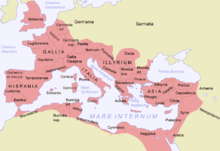Barbarian
History can be confusing - but that's because so much of it happened in the past. Like most historical notions, one man’s barbarian is another man’s rapacious neighbour, so who is to say what constitutes a barbarian?
The word "Barbarian" is of Greek origin and originally referred to any culture which re-used wedding cutlery instead of offering it to Prometheus by hurling it to the floor. Interestingly, “Barbarian” arrived in English from Medieval Latin and shares a stem with “Barber” – since the Catholic Church saw the practise of ritually slaying customers and rendering them into sausage as dangerously close to trans-substantiation.
It is perhaps inevitable then that we think of barbarians primarily as those tribes who violently opposed the Roman Empire. The Romans themselves took a pragmatic approach to the term and applied “Barbarian” to any culture other than their own, though few other peoples of the time could compete with ancient Rome’s sophisticated level of culture. Which other ancient tribe could claim to have introduced millions to the wonders of sanitation and universal civil law while simultaneously slaughtering its way across three continents, enslaving entire nations, feeding interesting new religious groups to wild animals and decorating their extensive road-network with the crucified corpses of uppity slaves?
It may be instructive, then, to take an overview of those cultures generally referred to by Classical historians as “Barbarians", many of whom eventually set out to attack their supposed betters in Rome itself.
The Goths
By 100 AD, as a result of their higher level of civilization, the Roman armies had perfected the art of genocide and had conquered lands equal in size to the Roman Empire. Such a conquest could never be held indefinitely, however, and even the power of the ancient world's only superpower began to drain away. The first tribe to take advantage of Rome's weakened position were the mighty Goths.
The Goths originated in Gottland in modern Sweden and migrated across the Baltic to the European mainland in about 212 AD, seeking lower taxation and Siouxie and the Banshees tickets. By 350 AD, they were spread across much of what is now Germany, mostly sitting lethargically under trees in an attempt to avoid sunlight. They could not have known that their new home lay directly in the path of invading horsemen from the desolate steppe-lands.
Scornful disapproval and an appreciation of jangly, alternative guitar music was no defence against the wild hordes from the East and soon the Goths had been split into two distinct groups, (Hissy-Goths and Austro-Goths) both seeking shelter in different parts of the Empire.
The Hissy-Goths
Of the two Goth groupings, it was the Hissy-Goths who first rebelled against their new masters, apparently appalled by the Romans' propensity for having a good time. They had crossed the Rhine and sought the protection of the local Roman governor but soon became disenchanted and rampaged listlessly across eastern Europe under new leader, Turmeric, who led them on to eventually invade Italy itself in search of a place in which they could feel yet more wretched.
Tacitus reports that Hissy-Goths were much given to terrifying moments of pique, black mascara and the slamming of bedroom doors to the accompaniment of their traditional warcry - "You just don't understand."
For the first time since Hannibal had laid waste to Italy with his army of Mastodons, Rome came under siege. Thirty thousand Hissy-Goths in war-hoodies surrounded the city, unable to surmount its defensive walls due to their poor diet and worn trainers. Well supplied with water, the Romans held out until until they were reduced to eating rats without olive oil. Not for the last time in Roman History a desperate situation was saved by a seemingly divine intervention. Rumours that a new shopping-mall had opened in Ravenna circulated, causing many Hissy-Goths to desert, selling their weapons and armour for train tickets so that they could hang around the new escalators and cast contemptuous looks at shoppers.
The threat of a second siege was forestalled when Rome bought off the Hissy-Goth army with 100 wagon-loads of black nail-varnish and a promise that they could paint their bedrooms purple without reprisals. However, Tacitus reports records that King Turmeric vowed to return just as soon as his mother stopped mithering him to take out the trash.
In his magnus opus, “Dialogus de oratoribus”, he quotes the Hissy-Goth king as saying:
"I, Turmeric, who art so Gothic I shit bats, will carve my name in the doors of the Temple of Jupiter."
Tactitus also portrays the fearsome leader displaying a knife to the crowd and easing his existential pain by carving abstract patterns in his own forearm. Whatever the truth of Tacitus' words, within weeks Turmeric had defeated weakened Roman legions at the Fields of Nephilim, trapping six legions in a ring of steel and forcing them to listen to highly amplified Bauhaus albums. As many as 5,000 legionaries may have died by their own hand, most having cut off and eaten their own ears in an attempt to escape their cruel fate.
The Austro-Goths
The Austro-Goths settled the upper Danube, around modern-day Vienna and are thought to have been much influenced by early Iron Age electronica, such as Kraftwerk. They also submitted to the authority of Rome and seemed particularly keen to sample the misery that enslavement could bring.
It is thought that the Austro-Goths spoke a language largely similar to the Hissy-Goths but with a heavier accent and a less accusative tone. Militarily their tactics appear to have differed very little, centring on unenthusiastic shrugging and barely disguised loathing. They did not join the Hissy-Goth assault on Rome as they were grounded at the time. Nevertheless, they gave heavy backing to the attack by creating a Facebook support group.
The Buns
Bunnish[1] tribes never sacked Rome themselves, but their dislocation of other barbarian tribes weakened the empire significantly, threatening the stability of cupcake production across the known world. Their migration into Eastern European lands around 370 AD in search of plunder, agricultural land and frosting had displaced the Goths, allowing the Buns to settle the lower Danube. Initially, the Buns caused Rome little concern due to internecine fighting and nut-allergy. Roman commanders even had hopes of absorbing the tribe into their empire as mercenaries, though these hopes were dashed by their demand to be paid in pecans - an ingredient not available until Cortes’ conquest of its native Mexico.
It was originally the horse that had allowed the Buns to move so far so quickly. But by 375 AD the Buns had improved their mobility by assembling several horses, with Roman sources suggesting that there may have been as many horses as mounted archers. With this tactical advantage, it was inevitable that one day a Bun leader would arise with ambition to match the ferocity of his people. That man was the infamous Attila the Bun.

Born in around 434 AD, Attila grew up motherless (self-raising) in a Bunnic region riven with internal strife. Rome had long been paying tribute to the Buns in the form of chocolate chips and sprinkles, but these riches had only served to cause division among the tribes. Attila ascended to the chieftainship of the smallest tribe, the Strudel, in 453 and soon defeated the pre-eminent Gateaux tribe. Within three years he had united the warring kingdoms of the Muffin and Waffle into a fearsome fighting force and had become the supreme Bun leader, or Éclair.
Under Attila, the Buns soon crippled the Eastern Roman (Byzantine) Empire, with a swift blow to the Balkans in 444 AD, before rampaging across Gaul in an orgy of looting, pillaging and diabetes in 446 AD. Emboldened by his success, Attila then set out to advance on Rome itself. The Romans had no answer to this onslaught of confectionery and retreated behind their mighty city walls, fearing death by chocolate. Even so, Attila would surely have taken the city had not an outbreak of Bakewell's disease spread through the Bun ranks.
We will never know what fate Attila had in mind for its citizens but, judging by his treatment of previously captured cities, the population could expected to be blended into a creamy consistency while their homes were burned and the "Eternal City" roasted at 240C (Gas Mark 8).
The Buns largely disappear from History at this point and it is thought that they migrated north, through the empire to settle in the Holstein region, eventually becoming Danish.
The Vandals
Perhaps inspired by their distant kin, the Hissy-Goths, or merely eaten up with boredom, the Vandals also set out to sack Rome. Like the Goths, the Vandals had migrated across Europe, fleeing before the advance of the Buns, searching for land that they could call their own and urinating in shop doorways as they fled. Once they had bridged the Rhine from Germany, the Vandals moved across Gaul swiftly, scratching cars and smashing church windows as they went.
Over the next thirty years they shop-lifted their way through Iberia and then audaciously crossed to Africa to carve their names into the pillars of Hercules. Safely ensconced in Carthage, they reverted to a more settled existence, breaking windows and setting fire to post-boxes.
North Africa suited the Vandals. Far from the ravages of the Buns and the vengeance of Rome, with its warm climate and multitude of classical temples in need of smashing, the ancient city of Carthage became their new capital. And it was from Carthage that Vandal king, Gastric, sailed his fleet in 455 AD with the aim of becoming the next Barbarian chief to sack the capital of the known world.
This time, however, there was little violence. Emperor Maximus fled rather than face the massed aerosol paints of the Vandals, and Gastric walked into the city unopposed. There was no mass-slaughter after the occupation, though the Vandal chieftain gave serious consideration to burning Rome. Gastric’s decision to spare the Eternal City has been interpreted as an effort to isolate himself from a splinter group of Vandals – the Arsonists. However, Pliny the Elder suggests that it was merely an effort to preserve Vandal tags sprayed on the Pantheon and other important civic buildings.
The Franks
More than any other tribe it was the Franks who benefitted from the decline of the Roman Empire. Like many other barbarians, the Franks first came to notice in the province of Germania and were noted by Suetonius as:
“Driving all before them with their brazen bluntness and devastating honesty”.
By the early fourth century the Frankish King Cletus controlled a territory almost half the size of the rapidly retreating Western Empire. Roman legions had learned to fear their coruscatingly guileless war-chant:
“Come an have a go, you garlic chewing, wop poofters.”
The last Roman army in the north was resoundingly defeated at the Battle of Vulvae. Here the Frankish champion, Ragnachar, faced down the entire XXIIth legion by describing his adversaries’ battle attire as “red mini-skirts and leather bondage gear” before launching into an sensational accusation that Romans only built public baths so that they could check-out each others’ wedding-tackle.
The humiliated legionnaires fled the field, leaving Cletus in charge of an Empire stretching from Cologne to Burgundy in which no physical abnormality went un-commented on and no eccentric behaviour was tolerated without public condemnation – policies which persist to this day in the great nation founded by these brutally plain-spoken people – Luxembourg.
The Scots
The Scots, or Scotti, were the people who inhabited Ireland during the Roman occupation of Britannia. It is uncertain how the Scots came to become trapped in Ireland but their exile is widely suspected to be the result of an over-exuberant drinking binge on a stag-weekend in Dublin leaving the tribe without the fare for the ferry home.
Eventually, many Scots returned to Britannia to raid the rich Roman province and were a constant thorn in the side of Roman governors. Some war-bands reached as far south as Londinium where they attempted to cripple the economy by consuming the entire province’s supply of wine, by telling the locals how much better life would be north of Hadrian’s Wall and by refusing to ever to return whence they had come.
A number of Scots settled in the area but were easily distinguished from the local population by their bright red complexion during the brief British Summer (July 21 – August 3rd), and their propensity for sitting in shop-doorways asking passers-by for money “Tae feed mae wee doggie”.
The Saxons
It is unclear if the Saxons challenged Roman authority violently, though the enormous investment in “Saxon shore forts” such as Pevensey Castle suggests that the Roman province of Britannia took the threat of their recycled Led Zeppelin riffs very seriously. Certainly by 365 AD, settlements of Germanic warriors armed with blond fright-wigs and flying-Vee axes had established themselves along the southern and south eastern coasts of Britannia. They might have penetrated further into the heart of the province had they not been distracted by the prospect of "cracking" America – a continent as yet undiscovered.
By 367 AD Emperor Valentian the Unromantic[2] appointed Senator Nectarine to be “Count of the Saxon Shore” to oversee these troublesome settlers/raiders. Nectarine reportedly found it difficult to coerce the Saxons into behaving through the threat of force since:
“These uncouth men appears to have metal heads immune to weapons, melody and thought alike. Their leather armour, though not strong, smells so powerfully of stale sweat that it is scarce possible to force one's men to approach to within a mile of them.”
Though fourth century records are sketchy, it seems that Nectarine[3] eventually bought off the Saxons with an annual subsidy of steel studs, amphetamines and motor cycle magazines. Once the Romans departed Britannia all together in 476 AD, the Saxons made some inroads against local Celtic tribes distracted by their humiliation at the hands of Glasgow Rangers in the SFA cup. Eventually, however, they appear to have been subsumed by a larger, more acute tribe, the Angles.
Footnotes
- ↑ Scholars now refer to Attila's hordes as "Buns" rather than the more traditional "Huns" after pioneering research by Cambridge University 's Head of Classical Anthropology Prof. R. O' Martus discovered that there was no "H" in the their language and that, due to a inherited speech-disorder, his warriors would have pronounced all aspirant sounds with a nasal phoneme equivalent to a "B" in English. Also, they were partial to a bit of cake.
- ↑ The otherwise unheralded Emperor Valentian was brother to Valentine, inventor of the eponymous cards. Valentian himself had no interest in romance, preferring to rent female company by the hour before having his guards murder his "girlfriends" on their way home to recover the fee. He did, however, always send a condolence card to his victim's family.
- ↑ Senator Nectarine survived his battles with the Saxons to become Duke of Orange, now in southwest France
| Featured version: 9 January 2011 | |
| This article has been featured on the main page. — You can vote for or nominate your favourite articles at Uncyclopedia:VFH. | |








